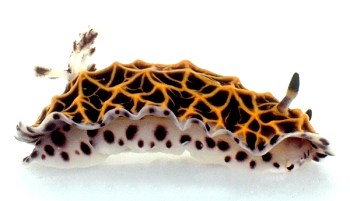
Halgerda wasinensis
Eliot, 1904
Order: NUDIBRANCHIA
Suborder: DORIDINA
Superfamily: EUDORIDOIDEA
Family: Dorididae
DISTRIBUTION
East Africa (Kenya, Tanzania, South Africa)
PHOTO
UPPER RIGHT: Bahari Beach, Dar es Salaam, Tanzania, 22mm long alive, February 1974. LOWER LEFT, RIGHT: Pangavini, Dar es Salaam, Tanzania, 25mm long alive, November 1976. PHOTOS: Bill Rudman.
Grows to at least 50mm long. The mantle is dark brown or black with a band of white around the margin. The mantle is covered with a pattern of ridges except around the edge. These ridges are edged in bright yellow. There are blackish brown spots in the white band round the mantle edge. The underside of the mantle and the foot are white with large rounded dark purplish brown or black spots. The upper twothirds of the rhinophore clubs are black and the lower third is yellowish, especially on the anterior side. The white rhinophore stalk has a black band down the posterior side. The gills are more pinnate and compact than in other species of Halgerda. They are translucent white with black patching.
Specimens I have examined from Kenya and Tanzania have relatively sharply angled mantle ridges and narrow yellow lines. However a photo of a South African animal in Gosliner's South African nudibranch book suggests that specimens from there have more rounded ridges and subsequently wider yellow lines.
Reference:
• Rudman, W.B. (1978) The dorid opisthobranch genera Halgerda and Sclerodoris from the Indo-West Pacific. Zoological Journal of the Linnean Society, 62: 59-88.
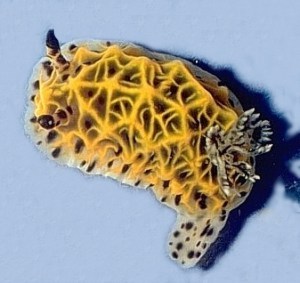
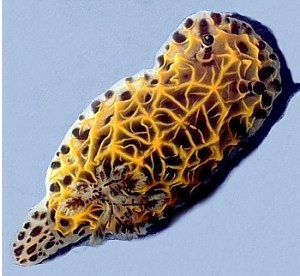
Rudman, W.B., 2000 (May 18) Halgerda wasinensis Eliot, 1904. [In] Sea Slug Forum. Australian Museum, Sydney. Available from http://www.seaslugforum.net/find/halgwasi
Related messages
Halgerda wasinensis? from Sodwana Bay
October 21, 2008
From: Colin Ogden
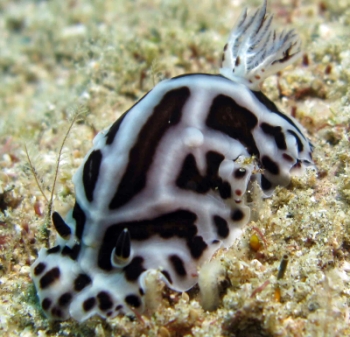
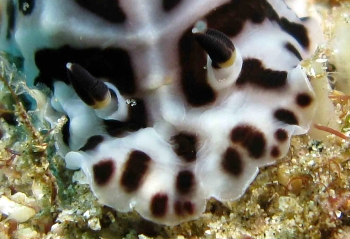
Concerning message #21501:
Hi Bill,
Here is another Halgerda that looks like it could be a H. wasinensis, but with all the yellow colour missing.
Locality: Sodwana Bay, 20 metres, South Africa, Indian, 07 October 2008, reef. Length: 40mm. Photographer: Colin Ogden.
Your opinion would be appreciated.
Regards
Colin
scubaco@iafrica.com
Ogden C. M., 2008 (Oct 21) Halgerda wasinensis? from Sodwana Bay. [Message in] Sea Slug Forum. Australian Museum, Sydney. Available from http://www.seaslugforum.net/find/21948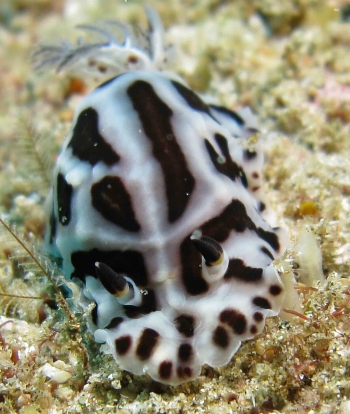
Dear Colin,
I look at new messages concerning Halgerda from southern Afirca with a certain fear and trepidation, because we clearly have a lot to learn about variability and species differences. Your photos were no exception - but then I noticed the yellow on the rhinophores below the black. This is a feature of the colour pattern of the 'typical' H. wasinensis illustrated on the Fact Sheet, and I think is unique to that species. So it is rather ironic that these animals, which essentially lack the yellow pigmentation usually found in H. wasinensis, have kept the little bit on their rhinophores which most links them to H. wasinensis. That is not to say that all the photos I have identified as H. wasinensis, are that species, but I suspect all the ones with black lines on the gills are most probably colour forms of it.
So thanks very much.
Best wishes,
Bill Rudman
Unknown Halgerda
April 29, 2008
From: Valda Fraser
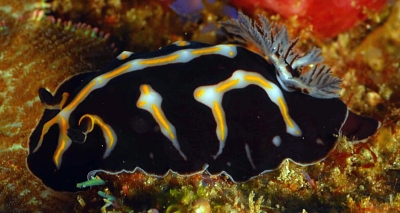
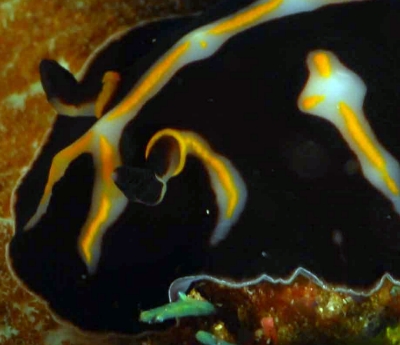
Concerning message #9599:
Dear Bill
What have we here? Maybe a Halgerda wasinensis variation. But, it's too different. Any ideas?
Locality: Ponta D'Oura, 41 m, Mozambique, Indian, 28 January 2008, On top of rocky reef . Length: 35 mm. Photographer: Valda Fraser.
Regards
Valda Fraser
valdafraser@mweb.co.za
Fraser, V.J., 2008 (Apr 29) Unknown Halgerda. [Message in] Sea Slug Forum. Australian Museum, Sydney. Available from http://www.seaslugforum.net/find/21501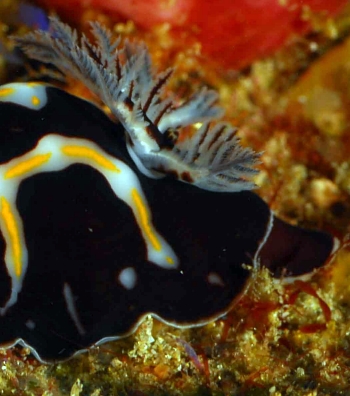
Dear Valda,
This is probably the same as species animal as the one in your earlier message [#2949]. If you look through messages from Sth Africa I have idenitified as H. wasinensis you will see many have this thin opaque white edge to the mantle. If I am correct, your animal here has an excess of black, and many of the yellow lined ridges are absent. As I said in response to another recent Halgerda message from Sth Africa [#20670], we still seem to have some work to do on this genus, especially in your part of the world.
Is it a variant of H. wasinensis? I dont think we can really say. Its possible all the very black specimens from sthn Africa which I have indentified as H. wasinensis are a distinct species, but there does seem to be a link between the black-spotted 'typical' forms from east Africa and the more heavily pigmented forms further south. At present I'll just have to say I am not sure.
Best wishes,
Bill Rudman
Halgerda wasinensis ? from Mozambique
March 31, 2008
From: David Abecasis
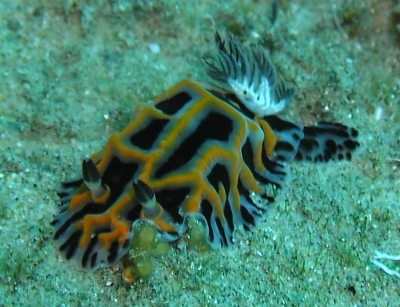
Hi Bill,
I believe this is some kind of Halgerda but I'm not sure. Can you help me with the ID?
Locality: Ponta do Ouro, 16 meters, Mozambique, Indian Ocean, 1 November 2007, sand with rocky patches. Length: ~25mm. Photographer: David Abecasis & Rita Abecasis.
Greetings,
David Abecasis
davidbecas@netcabo.pt
Abecasis, D., 2008 (Mar 31) Halgerda wasinensis ? from Mozambique. [Message in] Sea Slug Forum. Australian Museum, Sydney. Available from http://www.seaslugforum.net/find/21147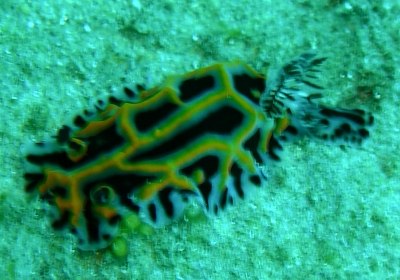
Dear David,
I'm afraid you are not the only one unsure about some of these Halgerda species. At the moment I am considering this a dark colour form of H. wasinensis but I have doubts. This form has black patches between the yellow ridges and the gills are white or colourless in the basal half while the upper half is lined with black. At present we have records of this form from Mozambique and Sth Africa.
Best wishes,
Bill Rudman
Re: More Halgerda wasinensis pics from Mozambique.
August 10, 2007
From: Natasja Vandeperre
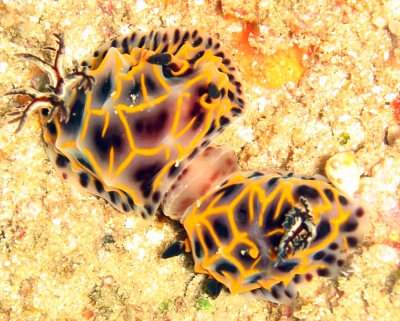
Concerning message #13237:
Hello Bill,
I have another mating Halgerda wasinensis picture from Tofo, Mozambique. Unfortunately they are both the lighter colour form.
Locality: Manta Reef, Tofo, 20m, Mozambique, Indian Ocean, 11 July 2007. Length: 20 mm. Photographer: Natasja Vandeperre.
Greetings,
Natasja
postmaster@naaktslakken.be
Natasja Vandeperre, 2007 (Aug 10) Re: More Halgerda wasinensis pics from Mozambique.. [Message in] Sea Slug Forum. Australian Museum, Sydney. Available from http://www.seaslugforum.net/find/20410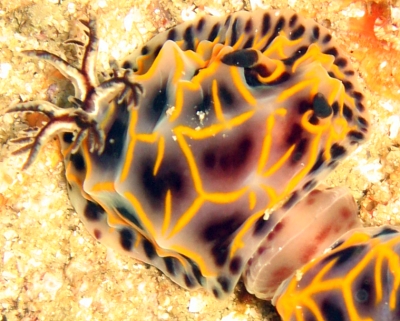
Dear Natasja,
Thanas for these. Yes it would be nice to get the two colour 'forms' mating but at least this photo shows how the black spots merge to form large black patches. It is also interesting to see the shape of the everted copulatory organs. It seems in this species the whole of the genital vestibule everts out of the body to form a flattened disc. It would be interesting to know if this is a character of all species of Halgerda. This sort of information can't usually be found when dissecting a preserved animal because the organs have retracted back into the body.
Best wishes,
Bill Rudman
Are these Halgerda formosa?
March 4, 2006
From: Pasquale Pascullo
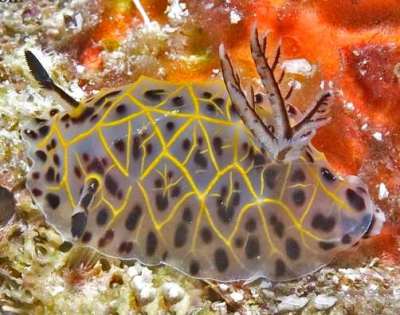
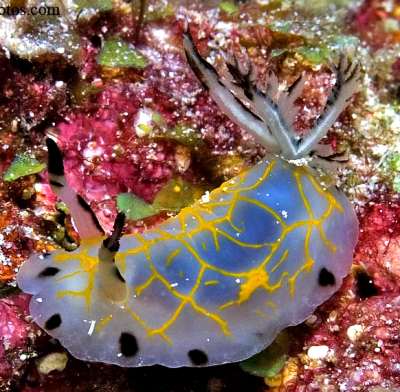
I thought these were Halgerda formosa but I know have my doubts. One has many more spots than the other. .
Locality: Pemba Islands, 12mtrs, Tanzania, East Coast Africa, Indian Ocean, Upper photo: 10 February, 2006. Lower photo: 5 February 2006. Length: 1 inch. Photographer: Pasquale Pascullo.
Your thoughts Bill?
As always, thanks for your time and sharing.
Pasquale Pascullo
www.ppfotos.com
pp@ppfotos.com
Pascullo, P., 2006 (Mar 4) Are these Halgerda formosa? . [Message in] Sea Slug Forum. Australian Museum, Sydney. Available from http://www.seaslugforum.net/find/16004Dear Pat,
Have a look at my comments [message #15243] on animals from nearby Zanzibar. I suspect these are colour forms of Halgerda wasinensis. You'll see the blackish tinge through the body wall. That is from a thin fibrous layer over the viscera, which is black. Not all species have this balck layer, but H. wasinensis certainly does. In H. formosa, there are usually thin parallel yellow lines [ridges] on the mantle, while in H. wasinesis the yellow lines form an angular network. I may be wrong but by combining the very dark typical forms of H. wasinensis with these light animals of yours, we finally seem to make sense of a range of problematic colour patterns found in the western Indian Ocean.
Best wishes,
Bill Rudman
Halgerda sp from Zanzibar
November 11, 2005
From: Wilhelm van Zyl
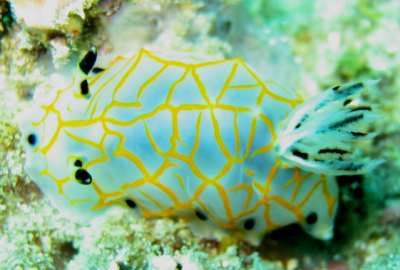
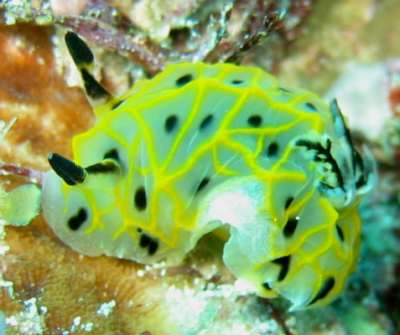
Dear Bill,
I recently returned from a diving trip to Zanzibar. Zanzibar and especially Pemba island is a Nudibranch enthusiast's dream. On one particular dive I photographed 9 different species.
I am sending you 2 pictures of what I believe is Halgerda formosa. The first specimen block spots only on the mantle's edge. The second one has spots in almost every segment formed by the ridges.
Locality: Pemba Island, Zanzibar, Tanzania. Indian Ocean. Depth: 14 m. Length: 2 cm. 14 October 2005. patchy coral and sandy reef. Photographer: Wilhelm van Zyl
Regards
Wilhelm van Zyl
diving@cyberdale.co.za
Van Zyl, F.W., 2005 (Nov 11) Halgerda sp from Zanzibar. [Message in] Sea Slug Forum. Australian Museum, Sydney. Available from http://www.seaslugforum.net/find/15243Dear Wilhelm,
I am jealous of you being to Zanzibar. I lived there for some months in 1971 and returned a few times while living later in Dar es Salaam. I will always remember its beauty, the abundant nudibranchs, and the friendliness of the people.
Your animals are very similar to one I had from Zanzibar (Rudman, 1978) and misidentified as Halgerda punctata. I have discussed its identity, and the identity of H. formosa in an earlier message [#11828]. Basically I think your animals are a pale colour form of Halgerda wasinensis. See message #11477 for some photos of intermediate colour forms.
Your photos are very useful as they help us to build up a picture of its distinctive colour characters. Three things which seem to be consistently present are that only the upper two-thirds of the rhinophore clubs are black, the tips of the rhinophores are white, and the gills are essentially white with black pigmentation restricted to the upper half of each gill.
Best wishes,
Bill Rudman
Colour variation in Halgerda wasinensis
July 5, 2005
From: Colin Ogden
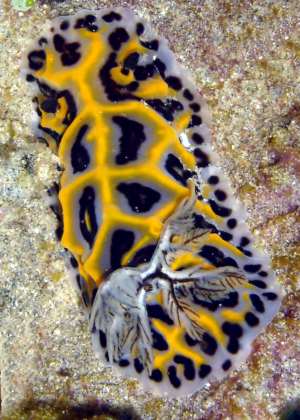
Hi Bill,
The more I learn about nudibranchs the more fascinated I become, and also the more confused I get by all their variations. I have three photos here of what I believe are Halgerda wasinensis, and they all have marked differences which I have noticed on this species before.
Upper right: shows definite white areas surrounding the black inside the yellow ridges.
Lower left: shows no black spots on the edge of the mantle, and a marked difference in the pattern of the ridges. Also the gills do not appear to end in "feathers" as in the other 2 photos. The black markings on the gills are definitely more pronounced than on the other 2 animals.
Lower right: shows definite white spots where the yellow ridges meet. All these photos are from the same area. I see there has already been some discussion on the variations found in this species. I hope my observations can contribute.
Locality: Sodwana Bay, South Africa, Indian Ocean. Depth: 22 to 26 metres
Length: 50 to 55 mm. 02 July 2005. Coral reef. Photographer: Colin Ogden
Regards,
Colin
scubaco@iafrica.com
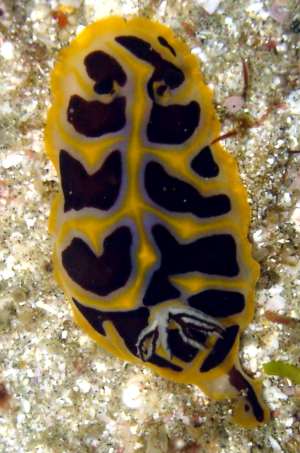
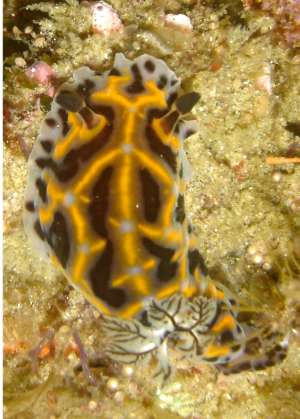
Dear Colin,
It's a while since we've had any problematic Halgerda photos on the Forum but I think your lower left photo is not H. wasinensis. The yellow border to the mantle and the foot seems quite distinctive. Perhaps Shireen Fahey or Terry Gosliner can give us a clue
Best wishes,
Bill Rudman
Mating Halgerda wasinensis from Mozambique
March 1, 2005
From: Riaan Marx
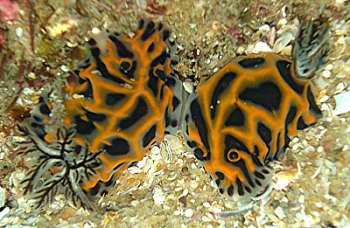
Dear Dr. Rudman,
It seems we are getting more and more photos of mating nudis...I'm starting to get concerned about the state of mind of our little community here... ;o)
Well, if you can't beat them, join them I always say...(refering to the photos of course and not the activity...). Hope you enjoy...erm, let me rephrase that...Hope you find these photos of Halgerda wasinensis informative...
Locality: Ponta Malongane, Creche reef, Mozambique. Indian Ocean. Depth: 11 metres. Length: 35 mm. 9 February 2005. Sandy/shelly area on rocky reef. Photographer: Riaan Marx
Regards
Riaan Marx
v-riaanm@microsoft.com
Marx, R., 2005 (Mar 1) Mating Halgerda wasinensis from Mozambique. [Message in] Sea Slug Forum. Australian Museum, Sydney. Available from http://www.seaslugforum.net/find/13236Dear Riaan,
Thanks for the photo. Mating photos are often quite valuable, especially when they show two quite different colour forms together, because this suggests our human idea of 'species difference' may be rather different from the species' view of 'sameness'. It would certainly be nice to see photos of this typical black colour form mating with the colour 'form' illustrated in your other message [#13237].
Best wishes,
Bill Rudman
More Halgerda wasinensis pics from Mozambique.
March 1, 2005
From: Riaan Marx
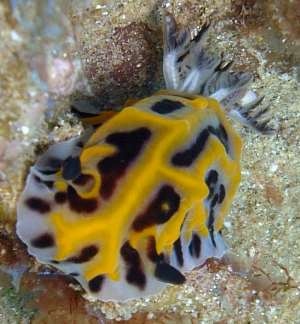
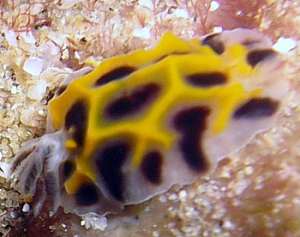
Dear Dr. Rudman,
I photographed these nudis, Halgerda wasinensis, in very close proximity. They were however moving away from each other, so I did not stick arround.
These pics again illustrate the wider yellow and more rounded black pattern found here in these parts of the world
Locality: Ponta Malongane, Mozambique. Indian Ocean. Depth: 13 m. Length: 20 mm and 25 mm. 9 February 2005. Sandy/shelly area on rocky reef. Photographer: Riaan Marx
Regards,
Riaan Marx
v-riaanm@microsoft.com
Marx, R., 2005 (Mar 1) More Halgerda wasinensis pics from Mozambique.. [Message in] Sea Slug Forum. Australian Museum, Sydney. Available from http://www.seaslugforum.net/find/13237Dear Riaan,
As I said in my comment on your photo of two H. wasinensis, of the typical dark colour form, mating [#13236], it would very interesting to see some interaction between that colour form and this colour form. I suspect this is also H. wasinensis, but it has fewer ridges, and the yellow lines are much broader. We still have a lot to learn about the biology of these animals. It would be good to know if they feed on the same sponges, whether their egg ribbons are the same etc, etc. Perhaps in Mozambique you will find a mixing of the 'typical' tropical form and this colour form which seems restricted to subtropical southern Africa.
Best wishes,
Bill Rudman
Re: Halgerda wasinensis? from East Timor
March 19, 2004
From: Nick Hobgood
Bill,
Concerning your comments [#12472 ]:
This individual was spotted last weekend on 14 March 2004 at around 9:30 am at around 5 meters depth. The GPS coordinates we have for the site are S 08° 33.435' - E125° 30.004'.
We will be on the lookout for more specimens.
Thanks!
Nick
nick@congo-pages.org
Hobgood, N., 2004 (Mar 19) Re: Halgerda wasinensis? from East Timor. [Message in] Sea Slug Forum. Australian Museum, Sydney. Available from http://www.seaslugforum.net/find/12480Thanks Nick,
Bill Rudman
Halgerda wasinensis? from East Timor
March 17, 2004
From: Nick Hobgood
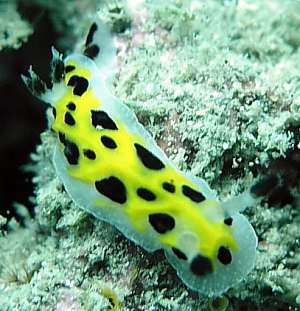
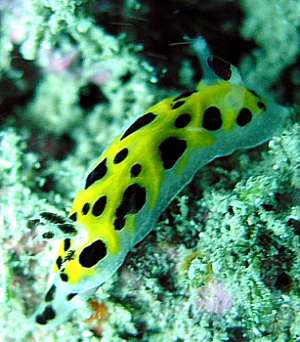
Dear Bill,
This little guy (~2cm) was found in 5-6 m water here in East Timor. I cannot find him in my field guides. Can you offer some help?
Thanks much
Nick Hobgood
Dina@congo-pages.org
Hobgood, N., 2004 (Mar 17) Halgerda wasinensis? from East Timor. [Message in] Sea Slug Forum. Australian Museum, Sydney. Available from http://www.seaslugforum.net/find/12472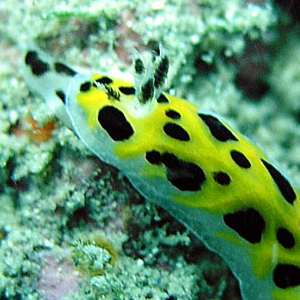
Dear Nick,
Any chance of a date and a few more locality details please? If we have this sort of information then the photos become a valuable bit of information.
I am afraid this is a bit of a mystery to me. Although there has been some excellent recent work on Halgerda we still have a lot to learn about the group. I guess it's a question of 'the more we know, the more we know we don't know'! One possibility is that this is a form of Halgerda wasinensis, but the white pustules around the mantle edge are quite reminsicent of Halgerda toliara, but that species doesn't seem to include forms with black spots.
We still have much to learn about these animals so at present I would tentatively identify it as H. wasinensis. Keep on the lookout for other colour forms, as any variations might help give us a clue to its identity
Best wishes
Bill Rudman
Halgerda wasinensis from NE South Africa
February 13, 2004
From: Charles Rowe
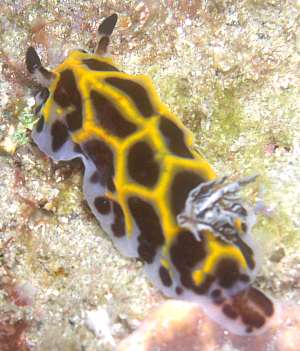
Hi Bill,
Here is another animal I find at Sodwana, NE South Africa.
7 Mile Reef - Sodwana KZN (Kwazula Natal) 7 January 2004
Best wishes
Charles Rowe
bumff@mweb.co.za
Rowe, C., 2004 (Feb 13) Halgerda wasinensis from NE South Africa. [Message in] Sea Slug Forum. Australian Museum, Sydney. Available from http://www.seaslugforum.net/find/12198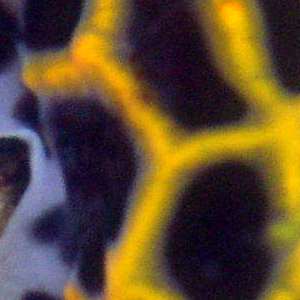
Dear Charles,
Unless I am gravely mistaken, this is a colour form of Halgerda wasinensis. In the close-up alongside you can see that the colour in the 'valleys' is not a solid black but consists of opaque black patches and regions where the black is showing through the body wall from the viscera, much like in many of the earlier photos on this page.
Best wishes
Bill Rudman
Halgerda formosa identity
January 7, 2004
From: Shireen Fahey
Hi Bill,
Terry and I took a look at Marina's recent message regarding her Mayotte collections along with the Halgerda photo. We're pretty sure that the photo is of Halgerda formosa and we'll certainly dissect it when we receive it from Marina. We've already dissected specimens with the spots as shown in Marina's photo, and they are H. formosa.
Meanwhile, Terry wants to clarify his previous message (January 30, 2003) regarding H. formosa. He didn't mean that the animal pictured is necessarily a new species altogether. His intuition told him that all the specimens (from Madagascar and Mauritius) may represent the same species (not necessarily a new species). We'll have to dissect the specimens with no spots next.
We'll keep you posted after the dissections are completed.
All the best,
Shireen
sfahey@calacademy.org
Fahey, S.J., 2004 (Jan 7) Halgerda formosa identity. [Message in] Sea Slug Forum. Australian Museum, Sydney. Available from http://www.seaslugforum.net/find/11528Dear Shireen,
I'm sorry I didn't post your message sooner but I have been overwhelmed with work in the last few months. Since your message arrived I have received a number of relevant contributions which I hesitate to suggest resolve the puzzle surrounding those problematic specimens of 'H. formosa' such as Marina's. I think they are H. wasinensis. I am posting 2 messages today discussing variation in H. wasinensis and H. formosa [message 1, message 2]. I would appreciate your comments. As a New Year's surprise for you. all today's messages concern your favourite genus - Halgerda.
Best wishes
Bill Rudman
Halgerda wasinensis from Kenya
January 7, 2004
From: Gavin Bushell

Dear Bill,
I have recently been to Kenya on a diving and safari trip, staying at Bamburi Beach, just north of Mombasa. The star find of the trip was the nudibranch in the pictures attached. I was having great difficulty in identifying it though, having realised it had external gills and could not therefore be Reticulidia halgerda. I soon realised it was one of the halgerdids. It took some browsing through the Website to spot the name "wasinensis" which I thought sounded very like Wasini Marine Park just south of Mombasa. I was hopeful when I opened the images and voila! Thank you very much for solving my problem.
The pictures were taken on 3 December 2003 at a dive site called Nyali Beach Reef. It was about 10 to 15 metres deep on the outside edge of the fringing reef. It was about 3 cms long. The substrate is fairly clear in the pictures, orange sponge, gunge and hydroids.
Gavin Bushell.
grbushell@mail.com
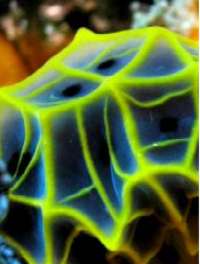
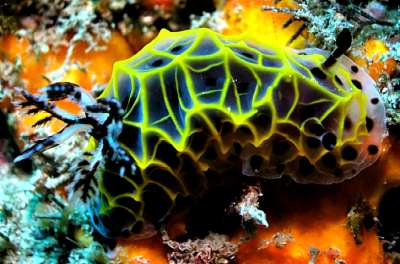
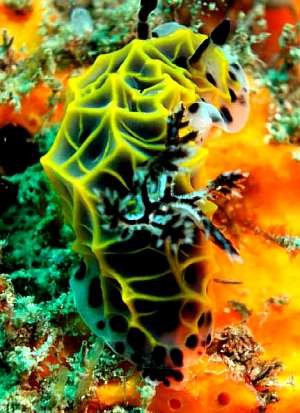
Dear Gavin,
I'm glad the Forum helped you identify your animal and even 'gladder' that you decide to share these photos with us as I think it has helped solved a major puzzle concerning the identity of a species of Halgerda which has defied our best attempts in the past. I have discussed this in a separate message. Like Yves Coze's photos showing variability in H. formosa, your photos have proved incredibly valuable in helping us to understand variation in H. wasinensis.
It's also very good to see your animal on an orange sponge, which looks quite like the one in one of Yves' photos which is most probably the food of H. formosa
Best wishes,
Bill Rudman
Halgerda wasinensis - colour variation
January 7, 2004
From: Bill Rudman
While looking at Gavin Bushell's photos of Halgerda wasinensis I suddenly realised they are a sort of 'Rosetta Stone' linking typical Halgerda wasinensis with a number of problematical animals which lack the black background colour, and have had a tortured presence on the Forum as 'perhaps' a strange form of Halgerda formosa. A recent example of this is Marina Poddubetskaia's message from Mayotte.
We normally think of H. wasinensis as having a black mantle and a network of yellow ridges, but as Gavin Bushell's photos show the colour is more complex than that. The black is made of two components. The first component is a large black spot in each 'valley' between the yellow ridges. The second component is a tough fibrous layer which encloses the visceral mass internally. In many species of Halgerda this visceral envelope is black. It is visible through the translucent body wall and gives this species its usually very dark background colour. In some animals the black spot on the skin would appear to enlarge to fill the whole space between the yellow ridges while in other animals the black internal envelope covering the viscera lacks black pigmentation or else the body wall is sufficiently thick to prevent the colour showing through the body wall. In these instances the animal appears white with scattered black spots. If this interpretation is correct then the animal I misidentified as Halgerda punctata in an earlier publication (Rudman, 1978) is almost certainly this species, as are most of the problematic specimens at present on the Forum under H. formosa, including photo 1, photo 2, photo 3, photo 1, photo 1.
Halgerda wasinensis can be defined externally as having a mantle covered with a reticulate pattern of thin yellow ridges and often with a strong background colour of black caused by the dark internal visceral envelope showing through the translucent body wall. Usually there is a rounded black spot in each 'valley' between the yellow ridges, and around the mantle edge there are many black spots. In some animals black spots are completely absent from the mantle.
The upper two-thirds of the rhinophore club is black, the lower third white,, and there are black spots, sometimes forming a continuous line along the posterior side of the white rhinophore stalk. The translucent white gills have scattered black spots and markings. The black sometimes appears as a continuous line but in smaller individuals it is present as a black tip. There are many black spots in a band around the edge of the white foot.
If this interpretation is correct then this species occurs throughout the Indian Ocean from eastern Africa to the Similan Ids in the Andaman Sea and Christmas Island, just south of Jakarta, Indonesia.
• Rudman, W.B. (1978) The dorid opisthobranch genera Halgerda and Sclerodoris from the Indo-West Pacific. Zoological Journal of the Linnean Society, 62: 59-88.
Bill Rudman
Rudman, W.B., 2004 (Jan 7) Halgerda wasinensis - colour variation. [Message in] Sea Slug Forum. Australian Museum, Sydney. Available from http://www.seaslugforum.net/find/11828Halgerda formosa? from Mayotte
November 26, 2003
From: Marina Poddubetskaia
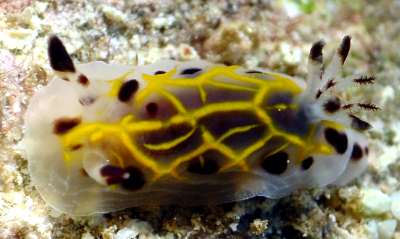
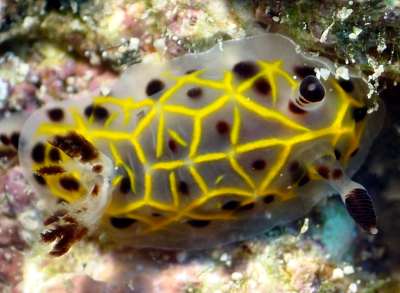
Note added 7 January 2004. This is almost certainly a form of H. wasinensis. See relevant discussion.
Dear Bill,
I'm just back from Mayotte (the Comoro Islands) where I realised a collecting mission to better know local opisthobranchs. The large lagoon of Mayotte proved to be very rich in sea slugs species.
I'd like to begin my contribution with these Halgerda formosa which have many more black spots than the animal I photographed in Mauritius. This ID was kindly confirmed by Shireen Fahey.
NB. The second animal seems to be on a pink sponge, but in fact it was moved for the photo from under the dead coral where it was found.
Location : Mayotte Island, France, Indian Ocean
Upper Photo: Passe en S, buoy n° 7bis
Depth: 13.5m, Size: 13-15mm. November 04, 2003
Lower Photos: Passe en S, buoys n° 6&7. Depth: 15m. Size: 15mm. November 15, 2003. Photos: Marina Poddubetskaia
Best wishes,
Marina.
nembro@nembro.info
Poddubetskaia, M., 2003 (Nov 26) Halgerda formosa? from Mayotte. [Message in] Sea Slug Forum. Australian Museum, Sydney. Available from http://www.seaslugforum.net/find/11477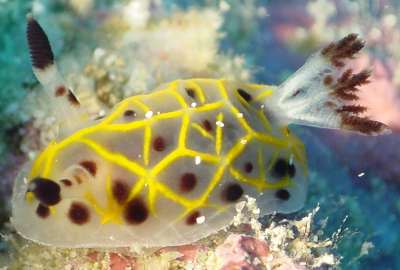
Dear Marina,
Thanks for these photos which help clarify my ideas about this group of species. This animal is clearly the one I incorrectly identified as Halgerda punctata some years ago (Rudman, 1978). It differs from Halgerda formosa In having the yellow lines [and ridges] arrange diagonally and forming a network over the mantle. Only the upper two-thirds of the rhinophore club is black, rarther than all the club in typical H. formosa and the upper third of the gills are black, rather than in H. formosa where there is a black line along the whole of the upper edge of the gills. Also in this species there are many black spots on the mantle while in H. formosa the spots, if present, are few in number.
See Terry Gosliner's message where he discusses the possibility of this animal being an unnamed species, a proposition which I totally agree with. To save confusion I should really sort out the examples of this species which are at present mixed up with 'typical' H. formosa on this page.
• Rudman, W.B. (1978) The dorid opisthobranch genera Halgerda and Sclerodoris from the Indo-West Pacific. Zoological Journal of the Linnean Society, 62: 59-88.
Best wishes
Bill Rudman
Halgerda wasinensis from South Africa
April 14, 2003
From: Riaan Marx
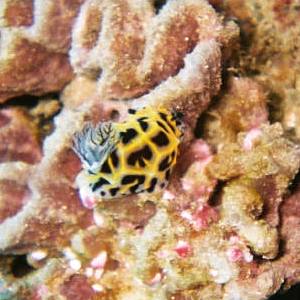
Here is another specimen of Halgerda wasinensis photographed on 7 mile reef at Sodwana Bay, South Africa. It is about 25mm in length (1 inch). Depth was about 17m (50 feet) and the picture was taken on 29 March 2003.
The reef is predominantly soft coral with hard coral filling up the wholes and prolific fish and other animal life. The bottom is quite sandy with a lot of sand also washed onto the hard coral patches. This was one of my first attempts at macro photography so the quality is not as good as some of the others shown, but I thought I’d send it in anyway…
Riaan.
riaan_marx@hotmail.com
Thanks Riaan,
Welcome to the Forum, and thanks for a record of an uncommon species. I am glad you decided to send your photo in. The Forum is not a photo contest. A photo which is good enough to allow us to identify the animal is much more value than no photo at all.
Best wishes
Bill Rudman
Halgerda formosa and H. punctata
January 28, 2003
From: Danny Van Belle
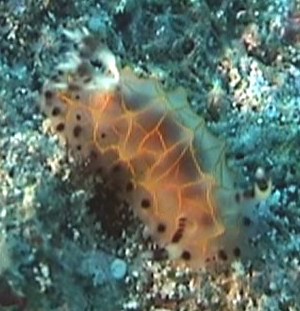
Hi Bill,
I filmed this Halgerda in February 2001.
Divesite: Christmas Point, Koh Bangu, Similan Islands
I went through the list of Halgerda on the site but couldn't find one which has the black spots on it's lower body half.
Danny
dannyvb@hotmail.com
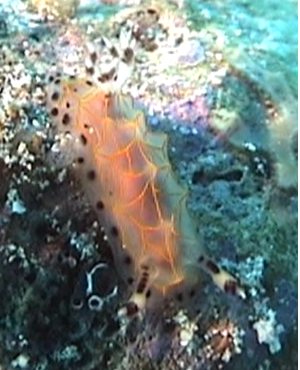
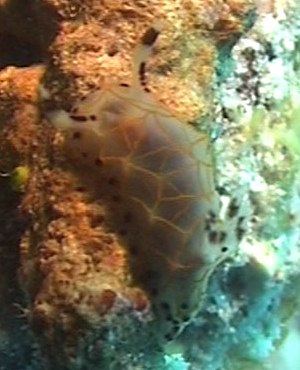
• Note added 7 January 2004. This is almost certainly a form of H. wasinensis. See relevant discussion.
• Note added 31 January 2003: This is not H. punctata. See Terry Gosliner's message and my comments
Dear Danny,
These are another group of interesting photos. This is a species which I identified many years ago (Rudman, 1978) as Halgerda punctata, but more recently (Fahey & Gosliner, 1998) it has been considered a synonym of Halgerda formosa. However, Marina Poddubetskaia's photos from Mauritius, and Bernard Picton's photos from east Africa suggest that H. punctata and H. formosa are quite distinct species. Marina's photos match the illustration in Bergh's description of H. formosa very well suggesting that it can be distinguished by the many secondary yellow lines running along the long axis of the mantle, and with only a few black spots arounf the edge. H. punctata on the other hand, as illustrated in your photos has yellow lines radiating out from each tubercle and with many scattered black spots around the mantle edge.
I will leave these as 'H. formosa' at present but I would like to hear from Shireen and Terry on what they think now we have more photos to compare
Best wishes,
Bill Rudman
Halgerda toliara or H. formosa from Madagascar
September 18, 2002
From: Lindsay Warren
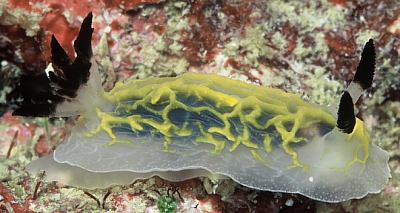
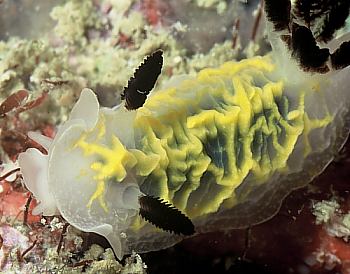
Note added 7 January 2004. This is almost certainly a form of H. wasinensis. See relevant discussion.
Dear Bill
I found several interesting opisthobranchs while diving around Nosy Be and Iles Mitsio off the northwest coast of Madagascar earlier this year. One of the finds was this Halgerda which is a bit of a puzzle. I found it on 24 January 2002 at about 8.30am at a depth of 54ft
while diving in the area of La Grotte, Ile Sakatia, NW Madagascar. L: 20mm.
Photos: Lindsay Warren.
I have checked through all the Halgerda on the Forum and the closest I could come to an ID is H. toliara. However, in your comments you mention that the viscera of this species are white while that of the one I found are black and that this is characertistic of H. formosa. However, the species I found does not have the black spots on the mantle which are characteristic in H. formosa but rather small white pustules on the mantle margin. The base of the branchial plume is translucent white with the upper half completely black as are the rhinophores, which is closer to H. toliara rather than H. formosa. What are your thoughts on this?
All the best
Lindsay
alldcl@compuserve.com
Warren, L., 2002 (Sep 18) Halgerda toliara or H. formosa from Madagascar. [Message in] Sea Slug Forum. Australian Museum, Sydney. Available from http://www.seaslugforum.net/find/6223Dear Lindsay,
Basically we still have much to learn about variability in these species. Whether the lining of the visceral cavity is black or translucent white seems to be a species specific character so its presence here would suggest your animal is closer to H. formosa than H. toliara. Another character used to distinguish these 2 species is the nature of the small tubercles around the mantle edge, translucent white in H. formosa and yellow in H. toliara. In your animal they are clearly translucent white. I agree there are no black spots on the mantle and the rhinophores lack some of the 'normal' colour pattern of H. formosa, but I think it is closer to that species than H. toliara. However what we clearly need is more local knowledge of this species group in the western Indian Ocean.
Best wishes,
Bill Rudman
Halgerda wasinensis from Christmas Island
May 3, 2002
From: W.B. Rudman
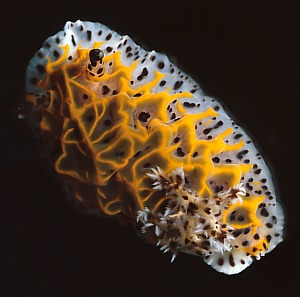
Here is a record of Halgerda wasinensis from John Hicks' Christmas Island, Indian Ocean collections.
PHOTO:
AM C131048, 35 mm long alive, August 1981, Ethel Beach, under rock, intertidal, Christmas Is., Indian Ocean. Photo: John Hicks
It is very similar externally to specimens illustrated here from Tanzania.
Best wishes,
Bill Rudman
Halgerda wasinensis from South Africa
September 3, 2000
From: Valda Fraser
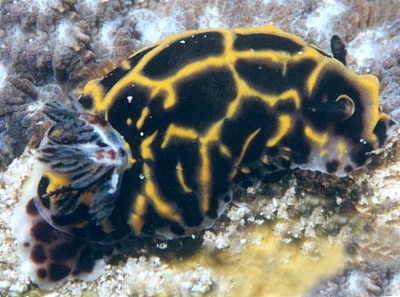
Dear Bill
I would agree with your comment.
Halgerda wasinensis from this area does have ".. more rounded ridges and subsequently wider yellow lines."
Locality: Sodwana, northern KwaZulu-Natal SOUTH AFRICA - 10m
Date: August 2000
Size: 35mm
Regards
Valda Fraser
valdafraser@mweb.co.za
Fraser, V., 2000 (Sep 3) Halgerda wasinensis from South Africa. [Message in] Sea Slug Forum. Australian Museum, Sydney. Available from http://www.seaslugforum.net/find/2949Thanks Valda,
Bill Rudman.
Re: Nudibranch from Mozambique
May 24, 2000
From: Vincent Tomeno
Dear Bill,
I have had a look at the picture you mentioned in Gosliner's South African book. It really looks like the nudibranch I saw. I agree with you and I think now that we can say it IS a Halgerda wasinensis.
Thanks for all.
Vincent
vtomeno@cybercable.fr
Tomeno, V., 2000 (May 24) Re: Nudibranch from Mozambique. [Message in] Sea Slug Forum. Australian Museum, Sydney. Available from http://www.seaslugforum.net/find/2443Re: Jorunna? or Halgerda? from Mozambique
May 20, 2000
From: Vincent Tomeno
Hello.
Concerning your question about whether the animal had ridges or not. Well, as far as I can remember, the body of this specimen didn't show any ridges.
I'm not sure, as I didn't know that this nudibranch would be difficult to identify, and I didn't look very carefully, but the body really seemed smooth.
I apologise for the poor quality of the picture, but I don't have macro lenses, and the pictures I sent you were enlarged and "sharpened" a bit. Maybe this sharpening suggests ridges where there wasn't.
Vincent Tomeno
vtomeno@cybercable.fr
Tomeno, V., 2000 (May 20) Re: Jorunna? or Halgerda? from Mozambique. [Message in] Sea Slug Forum. Australian Museum, Sydney. Available from http://www.seaslugforum.net/find/2421Dear Vincent,
The more I look at it the colour is wrong for Jorunna sp. 2. Your second photos clearly show a white band around the mantle edge with black spots, which is found in H. wasinensis but not Jorunna sp. 2. So even though you are not sure about ridges I think I will tentatively identify it as Halgerda wasinensis. As I said in the earlier message, although the animals I have see all have fairly noticeable ridging, Terry Gosliner has a photo of an animal from South Africa with much lower rounded ridges.
You don't need to apologise for the photos, it's just unfortunate that you photographed one which looks a bit like two different species.
Best wishes,
Bill Rudman.
Jorunna? or Halgerda? from Mozambique
May 19, 2000
From: Vincent Tomeno
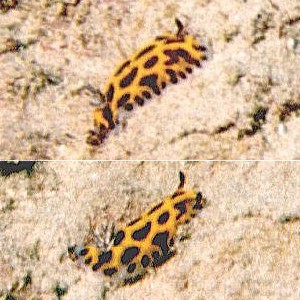
First of all, thank you for your help.
Here are a few informations about this nudibranch:
It was approximatively 30mm long, and I saw it in the South of Mozambique (Ponta de Ouro)
I took three pictures of that nudibranch, so here are the other two.
Vincent.
vtomeno@cybercable.fr
Tomeno, V., 2000 (May 19) Jorunna? or Halgerda? from Mozambique. [Message in] Sea Slug Forum. Australian Museum, Sydney. Available from http://www.seaslugforum.net/find/2415Dear Vincent,
I'm glad you sent the other two photos as they show me a completely different aspect of the animal. I think now that it is not Jorunna sp. 2 but a species of Halgerda, probably Halgerda wasinensis. I have just prepared a page for that species so you can have a look for yourself.
The side views in your latest photos suggest that the yellow pattern is a pattern of yellow ridges and the black regions are sunken pits. I can also see a white band with black spots around the edge of the mantle which is characteristic of Halgerda wasinensis and vertainly not seen in the yellow form of Jorunna sp. 2.
The only difference between your animal and the ones I have seen and photographed in east Africa is that the ridges in your animal seem to be more rounded, and so the yellow bands are broader. However as I comment on the species page above, An animal in Gosliner's South African book has a colour similar to your animal from Mozanbique.
Can you confirm that your animal had yellow ridges?
Best wishes,
Bill Rudman.
Jorunna from Mozambique
May 18, 2000
From: Vincent Tomeno
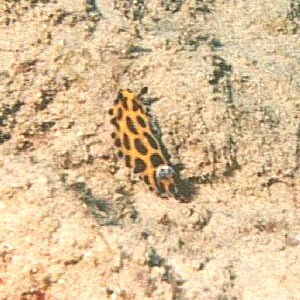
I was on holiday in Mozambique in February, and I took a picture of a sea slug that I can't identify.
Can somebody help me, please?
Vincent Tomeno
http://v.tomeno.free.fr/
vtomeno@cybercable.fr
Tomeno, V., 2000 (May 18) Jorunna from Mozambique. [Message in] Sea Slug Forum. Australian Museum, Sydney. Available from http://www.seaslugforum.net/find/2389Dear Vincent,
I am pretty sure your animal is the species of Jorunna I am calling Jorunna sp. 2. Can you give me an indication of size? As you will see on this page this species is quite variable in colour and has been reported from South Africa to the Western Pacific.
One interesting possibility is that Jorunna sp. 2 is a species Baba described from Japan as Thordisa parva Baba, 1938. The original illustrations were of a white animal with scattered black papillae. Two recent Japanese books identify this yellow and black animal as Jorunna parva. In Ono, 1999 there is a photo of a yellow animal with the black papillae clustered into patches. It also has a large black mark on the posterior tip of the foot which is characteristic of Jorunna sp. 2. In Suzuki, 2000 there are photos of white and yellow animals with scattered black papillae. Unfortunately the foot is not visible in these photos so I cannot comment on the presence or absence of the black posterior patch on the foot. If someone could confirm the black patch on the foot in the pale Japanese form which matches Baba's original description of Thordisa parva, I think we could be confident in identifying Jorunna sp. 2 with Baba's Thordisa parva. My examination of its anatomy shows that it is a species of Jorunna.
If you have any other photos you would like identified please send them to the Forum. If you can provide some basic locality information and give a rough idea of size it would make the information valuable as a record of the species.
Best wishes,
Bill Rudman.
Halgerda formosa? from East Africa
March 9, 2000
From: Bernard Picton
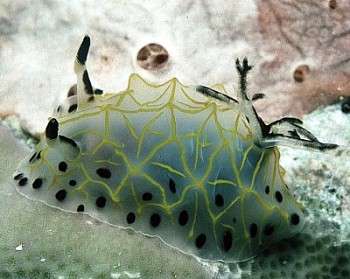
Note added 7 January 2004. This is almost certainly a form of H. wasinensis. See relevant discussion.
Dear Bill,
Here is a picture of a specimen collected off Pemba Island, Tanzania in February 1999 which I believe to be Halgerda formosa (H. punctata?) but I was not certain if the gills of the one you illustrated were much more branched and dense. I saw three individuals of this species so have some other photographs if it is interesting.
Best wishes,
Bernard
bernard.picton.um@nics.gov.uk
Picton, B., 2000 (Mar 9) Halgerda formosa? from East Africa. [Message in] Sea Slug Forum. Australian Museum, Sydney. Available from http://www.seaslugforum.net/find/2014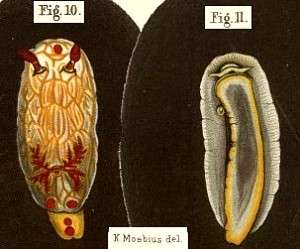
Dear Bernard,
This certainly looks like the animal I described from Zanzibar and identified as H. punctata, and which Fahey & Gosliner (1999) have reindentified as H. formosa. If your other photos show any colour variation and/or parts of the foot it would be interesting to include them as well.
I have included the original colour figures of Halgerda formosa published by Bergh in 1888 (Pl 77, figs 10, 11) some time later than the original description. They are from paintings by Moebius. I assume the red spots were originally a darker purple, though I am not too sure of the gills and rhinophores.
Best wishes,
Bill Rudman.
Name Change of Halgerda punctata
November 18, 1999
From: Ernest C.J. Seamark
Note added 7 January 2004. This is almost certainly a form of H. wasinensis. See relevant discussion.
Dear Bill,
According to the recent ANEWS Shireen J. Fahey and Terry Gosliner have ID Halgerda punctata as that of Halgerda formosa Bergh, 1880. Therefore Halgerda punctata in the present species list is H. formosa.
Thanks
Ernest C.J. Seamark
kearneyt@biology.und.ac.za
Seamark, E.C.J., 1999 (Nov 18) Name Change of Halgerda punctata. [Message in] Sea Slug Forum. Australian Museum, Sydney. Available from http://www.seaslugforum.net/find/1547Dear Ernest,
A couple of days ago I mentioned the name change while discussing Valda Fraser's message about Halgerda toliari. I'm afraid I had not had time to change the name on your photo of Halgerda punctata - formosa already on the site so thanks for drawing my attention to it.
Bill Rudman.
Halgerda punctata from South Africa
July 20, 1999
From: Ernest C.J. Seamark
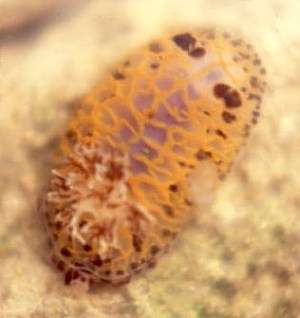
Note added 7 January 2004. This is almost certainly a form of H. wasinensis. See relevant discussion.
Dear Bill
This individual was collected 17 September 1997, from Treasure Beach intertidal area, South Africa. One other was found but specimen was lost whilst trying to collect.
[Treasure Beach is in Durban, KwaZulu Natal, South Africa.]
Ernest Seamark
kearneyt@biology.und.ac.za
Seamark, E. C. J., 1999 (Jul 20) Halgerda punctata from South Africa. [Message in] Sea Slug Forum. Australian Museum, Sydney. Available from http://www.seaslugforum.net/find/1044Dear Ernest,
It certainly matches an animal from Zanzibar that I identified with H. punctata but there is still some doubt about the actual identity of Farran's species.
If you find some more specimens they would be worth keeping.
Reference: Rudman, W.B. (1978) The dorid opisthobranch genera Halgerda and Sclerodoris from the Indo-West Pacific. Zoological Journal of the Linnean Society 62: 59-88.
Best wishes,
Bill Rudman.
